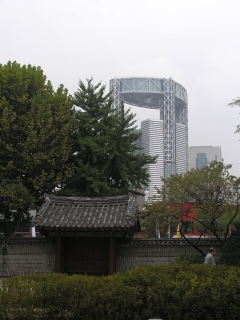Seoul, South Korea I
 When I first arrived in Tokyo, I looked at a map only to find most of it was concrete. Unlike North American and European cities, there is no tradition of open space in urban centers. It has been filled with housing and markets for 500 years. In this sense, civilization it older in East Asia than Europe. The small patches of greenery I could find on maps, I would arrive to realise it was nearly entirely paved with "institutional buildings" or walkways. A few standing trees and some shrubs don't qualitfy as a park.
When I first arrived in Tokyo, I looked at a map only to find most of it was concrete. Unlike North American and European cities, there is no tradition of open space in urban centers. It has been filled with housing and markets for 500 years. In this sense, civilization it older in East Asia than Europe. The small patches of greenery I could find on maps, I would arrive to realise it was nearly entirely paved with "institutional buildings" or walkways. A few standing trees and some shrubs don't qualitfy as a park.What I have come to understand after six months in Tokyo is that park space is defined by private, religious organizations. The cities themselves do not set aside lands. Rather, old Buddhist temples are preserved. This oasis replaces the need for traditional Western park space. The resulting difference is substantial.
Whereas in the West, empty parklands are valued -- consider Central Park. Beyond its "natural" shaping, it stands nearly empty short of an occasional skating rink, the zoo, or the Metropolitan Museum of Art. Buddhist temples in East Asia present a combination of ancient buildings (or more often not ancient, but re-built postwar) with parklands. Now imagine this squeezed between the Asian economic boom of the last twenty years. The combination provides a stunning comparison between new and old as captured in this photograph.


0 Comments:
Post a Comment
<< Home